#FuerzaMatanzas
Several of them had burns on the back of the neck and ears, or a hand or a foot bandaged, resting beneath a canopy or on the grass, in conditions clearly improvised. “We could go to places that are prepared in the city, but no one wants to leave from here.” Nearby, team leaders were coolly giving instructions: install more pumps, bring more water, make more spray, and connect more tubes. All is done with the naturalness of the sense of duty that pervades the land of Martí and Fidel.
The enemies of the Cuban Revolution tried to present it as evidence of a failed state: a fire of immense magnitude at the base for petroleum supertankers in the industrial zone of Matanzas, caused by an oil tank being struck by lightning. But the reality was that the Cuban Revolutionary Government was able to mobilize the necessary resources to control the fire in five days and to totally extinguish it in seven. Cuba could not have done it without the support of Mexico and Vene…



